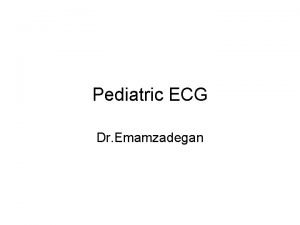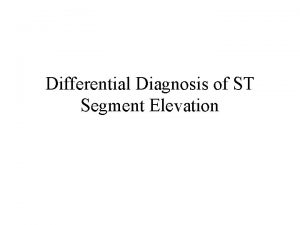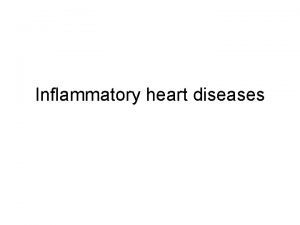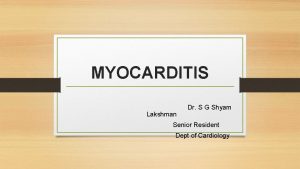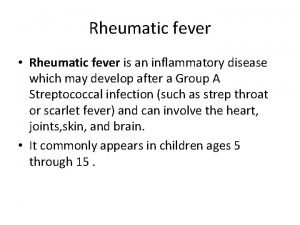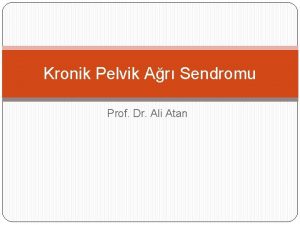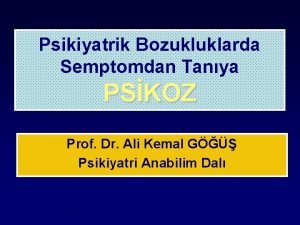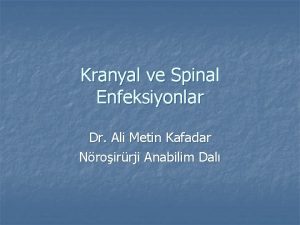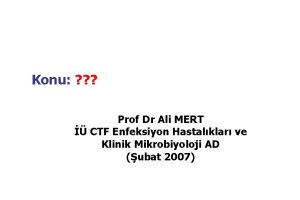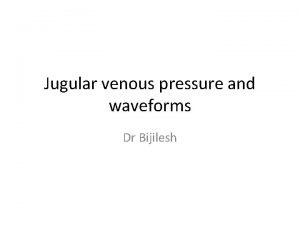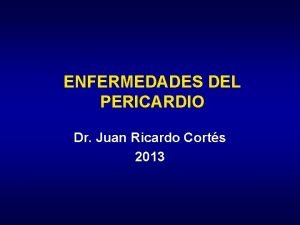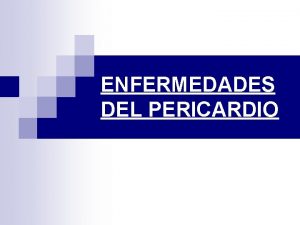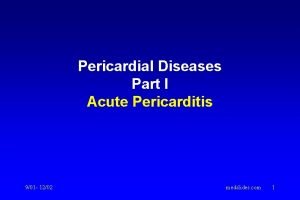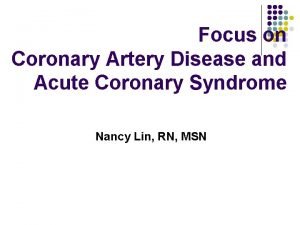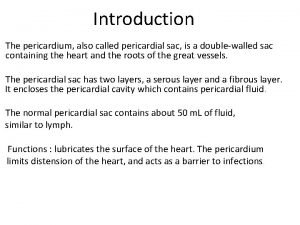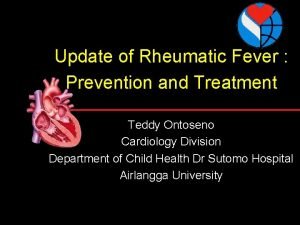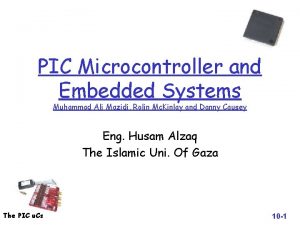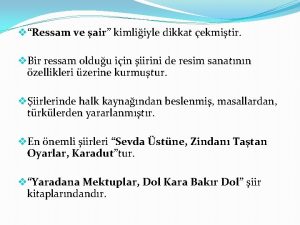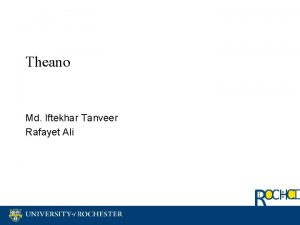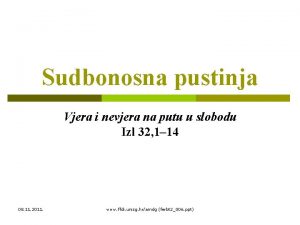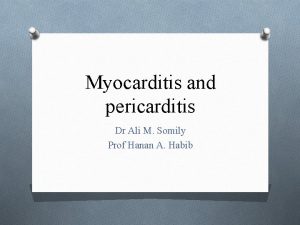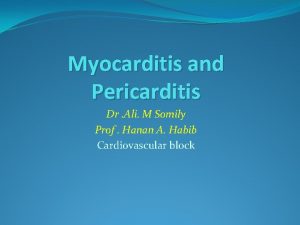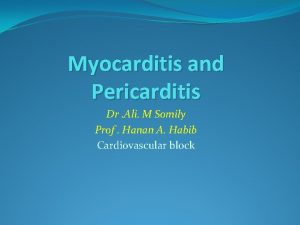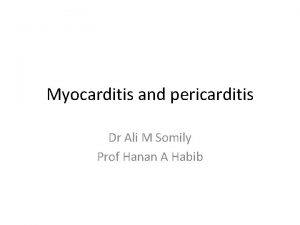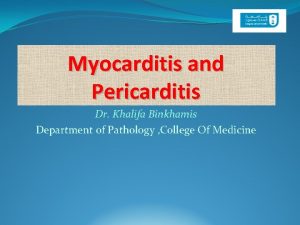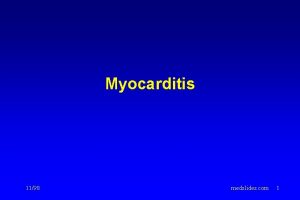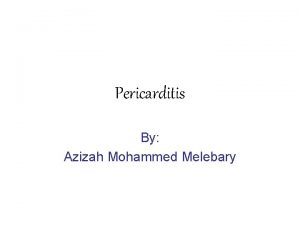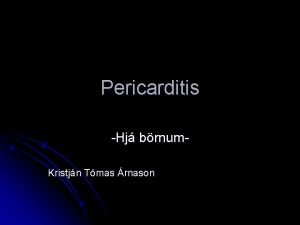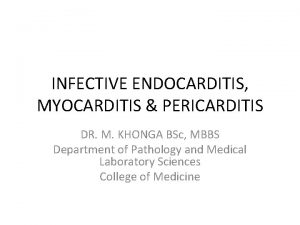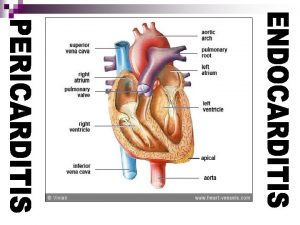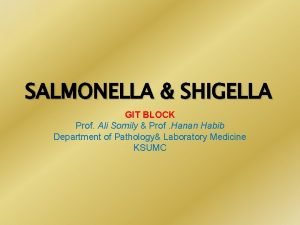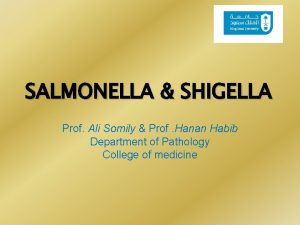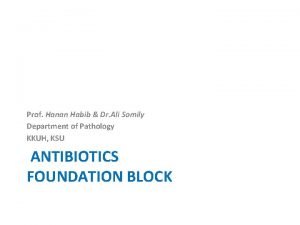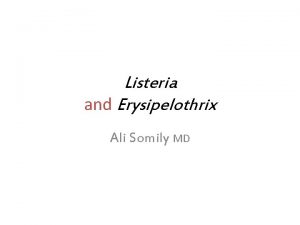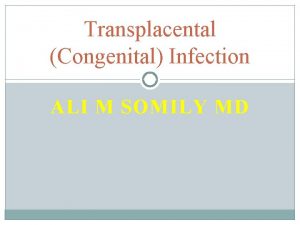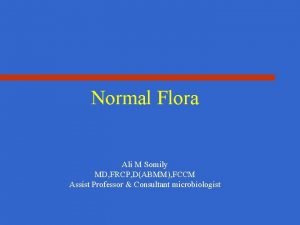Myocarditis and Pericarditis Dr Ali M Somily Prof

































- Slides: 33

Myocarditis and Pericarditis Dr. Ali. M Somily Prof. Hanan A. Habib Department of Pathology

Objectives �Describe the epidemiology, risk factor for myocarditis. �Explain the pathogenesis of myopericarditis. �Differential between the various types of myocarditis and pericarditis. �Name various etiological agents causing myocarditis and pericarditis. �Describe the clinical presentation and differential diagnosis of myocarditis and pericarditis. �Discuss the microbiological and non microbiological methods for diagnosis of myocarditis and pericarditis. �Explain the management , complication and prognosis of patient with myocarditis and/or pericarditis.

Myocarditis �Myocarditis is inflammatory disease of the heart muscle. �Mild & self-limited with few symptoms OR severe with progression to congestive heart failure & dilated cardiac muscle. �localized or diffuse �Myocarditis can be due to a variety of infectious and non infectious causes. �Viral infection is the most common cause �Others like toxins , drugs and hypersensitivity immune response.


Myocarditis

Epidemiology , Etiology and Risk Factors �Epidemiology : no accurate estimate of incidence as many cases are mild & brief and diagnosis is not made. �Coxsackie virus B is the most common cause of myocarditis �Other virus like Coxsackie virus A, Echoviruses, Adenoviruses , Influenza, EBV, Rubella, Varicella, Mumps, Rabies, Hepatitis viruses and HIV. �Bacterial causes include Corynebacterium diphtheriae, Syphilis , Lyme disease or as a complication of bacterial endocarditis.

�Parasitic cause includes Chagas diseases, Trichinella spiralis, Taxoplasma gondii and Echinococcus. �Others organisms includes Rickettsiae, Fungi, Chlamydia, enteric pathogens, Legionella and Mycobacterium tuberculosis. �Giant cell myocarditis due to Thymoma, SLE (Systemic Lupus Erythematosus ) or Thyrotoxicosis.

Infectious Noninfectious Viruses 1. Coxsackie B 2. HIV Systemic Diseases 1. SLE 2. Sarcoidosis 3. Vasculities(Wegener’s disease) 4. Celiac disease Bacterial 1. Corynebacterium diphtheriae (diphtheria) Neoplastic infiltration Protozoan 1. Trypanosoma cruzi (Chagas disease) Drugs & Toxins 1. Ethanol 2. Cocaine 3. Radiation 4. Chemotherapeutic agents Doxorubicin Spirochete

Clinical Presentation �Highly variable ; days to weeks after onset of acute febrile illness or with heart failure without any known antecedent symptoms. �Fever, headache, muscle aches, diarrhea, sore throat and rashes similar to any viral infection �Chest pain, arrhythmias , sweating , fatigue and may present with congestive heart failure.

Differential Diagnosis �Acute Myocarditis �Vasculitis �Cardiomyopathy ( due to drugs or radiation)

Diagnosis �WBCs, ESR, Troponine and CK-MB usually elevated �ECG (nonspecific ST-T changes and conduction delays are common) �Blood cultures � Viral serology and other specific test for Lyme disease, diphtheria and Chagas disease may be indicated on a case by case basis. �Chest X-rays : show cardiomegaly �Radiology : MRI and Echocardiogram �Heart muscle biopsy

ECG of normal heart

Endomyocardial Diagnosis �Pathologic exam may reveal lymphocytic inflammatory response with necrosis, but this is not sensitive because of the patchy areas of distribution. �“Dallas” criteria for histopathologic diagnosis �“Giant cells” may be seen.

Giant cells-myocarditis

Management �Often supportive; �Restricted physical activity in heart failure. �Specific antimicrobial therapy is indicated when an infecting agent is identified. �Treatment of heart failure arrhythmia �Other drugs indicated in special situations like anticoagulant, NSAID (nonsteroidal antiinflammatory drugs) , steroid or immunosuppressive immunomodulatory agents. �Heart transplant

Management �Most cases of viral myocarditis are self limited. �One third of the patients are left with lifelong complications, ranging from mild conduction defects to severe heart failure. �Patient should be followed regularly every 1 -3 months. �Sudden death may be the presentation of myocarditis in about 10% of cases.

Acute Pericarditis

Pericarditis �Pericarditis is an inflammation of the pericardium usually of infectious etiology ( viruses, bacterial, fungal or parasitic) Viral Pericarditis: �Coxsackievirus A and B, Echovirus are the most common causes. �Other viruses includes Herpes viruses, Hepatitis B , Mumps, Influenza, Adenovirus , Varicella and HIV.

Pathophysiology �Contiguous spread �lungs, pleura, mediastinal lymph nodes, myocardium, aorta, esophagus, liver. �Hematogenous spread �septicemia, toxins, neoplasm, metabolic �Lymphangetic spread �Traumatic or irradiation

Pathophysiology �Inflammation provokes a fibrinous exudate with or without serous effusion �The normal transparent and glistening pericardium is turned into a dull, opaque, and “sandy” sac �Can cause pericardial scarring with adhesions and fibrosis.

�Bacterial Pericarditis usually a complication of pulmonary infections (e. g. pneumonia , empyema): S. pneumonia, M. tuberculosis, S. aureus, H. influenzae, K. pneumoniae & Legionella. �HIV patients may develop pericardial effusions (M. tuberculosis , M. avium complex). �Disseminated fungal infection (Histoplasma, Coccidioides) �Parasitic infections (disseminated toxoplasmosis, contagious spread of Entamoeba histolytica )are rare causes.

Types of Pericarditis �Caseous Pericarditis commonly tuberculous in origin. �Serous Pericarditis due to autoimmune diseases (rheumatoid arthritis, SLE). �Fibrous Pericarditis a chronic pericarditis usually suppurative, caseous, or encased in a thick layer of scar tissue.

Types of Effusive Fluid �Serous �Transudative - heart failure �Suppurative �Pyogenic infection with cellular debris and large number of leukocytes �Hemorrhagic �Occurs with any type of pericarditis especially with infections and malignancies �Serosanguinous 9/98 medslides. com 23

Constrictive Pericarditis �Idiopathic �Radiotherapy �Cardiac surgery �Connective tissue disorders �Dialysis �Bacterial infection 24

Clinical presentation �Patients with pericarditis will present with sudden pleuretic chest pain, fever, dyspnea and a friction rub. �Patient with tuberculous pericarditis has insidious onset of symptoms. �On examination exaggerated pulses , paradoxus JVP and tachycardia. �As the pericardial pressure increases, palpitations , presyncope or syncope may occur.

Tuberculous Pericarditis �Incidence of pericarditis in patients with pulmonary TB ranges from 1 – 8 % �Physical findings: fever, pericardial friction rub, hepatomegaly �Tuberculin skin test usually positive �Fluid smear for AFB often negative �Pericardial biopsy more definitive 9/98 medslides. com 26

Acute Pericarditis Differential Diagnosis �Acute myocardial infarction �Pulmonary embolism �Pneumonia �Aortic dissection

Diagnosis �ECG will show ST elevation, PR depression and T-wave inversion may occur later. �Blood culture �Leukocytosis and an elevated ESR are typical �Other routine testing : urea and creatinine. �Tuberculin skin test is usually positive in tuberculous pericarditis. �Chest x-ray may show enlarged cardiac shadow or calcified pericardium and CT scan show pericardial thickening >5 mm. �Pericardial fluid or pericardial biopsy specimens for fungi, antinuclear antibody tests and Histoplasmosis complement fixation indicated in endemic area.



Management �Management is largely supportive for cases of idiopathic and viral pericarditis including bed rest , NSAIDS ( non-steroidal anti-inflammatory drugs) and Colchicine. �Corticosteroid is controversial and anticoagulants usually contraindicated. �Specific antibiotics must include activity against S. aureus and respiratory bacteria. �Antiviral: Acyclovir for Herpes simplex or Varicella. Ganciclovir for CMV.

Management �Pericardiocentesis to relief tamponade. �Patients who recovered should be observed for recurrence. �Symptoms due to viral pericarditis usually subsided within one month.

Pericardiocentesis
 Pericarditis vs myocarditis ecg
Pericarditis vs myocarditis ecg Pericarditis vs myocarditis
Pericarditis vs myocarditis Pericarditis vs myocarditis
Pericarditis vs myocarditis Fiedler's myocarditis
Fiedler's myocarditis Myocarditis
Myocarditis Serous diffuse myocarditis
Serous diffuse myocarditis Aschoff nodules
Aschoff nodules Prof dr ali hossain
Prof dr ali hossain Hunner ülseri
Hunner ülseri Verbijerasyon
Verbijerasyon Prof. dr. ali metin kafadar kimdir
Prof. dr. ali metin kafadar kimdir Ali fuat güneri
Ali fuat güneri Prof dr ali mert
Prof dr ali mert Kode icd 10 hydrocele testis
Kode icd 10 hydrocele testis Site:slidetodoc.com
Site:slidetodoc.com Differential diagnosis for pericarditis
Differential diagnosis for pericarditis Electrocardiograma pericarditis
Electrocardiograma pericarditis Posicion mahometana pericarditis
Posicion mahometana pericarditis Mediastinitis
Mediastinitis Pericarditis
Pericarditis Myocardial infarction pain location
Myocardial infarction pain location Pericarditis
Pericarditis Visceral layer of serous pericardium
Visceral layer of serous pericardium Fibrinous pericarditis
Fibrinous pericarditis Microprocessor and microcontroller by muhammad ali mazidi
Microprocessor and microcontroller by muhammad ali mazidi Economic development vs economic growth
Economic development vs economic growth Prof ram meghe institute of technology and research
Prof ram meghe institute of technology and research Türk denizciliğini destanlaştıran şair
Türk denizciliğini destanlaştıran şair Rafayet ali
Rafayet ali Ali afzal malik
Ali afzal malik Nevjera ali umire
Nevjera ali umire Ali sekmen
Ali sekmen Ali imran159
Ali imran159 Mohamed father in law
Mohamed father in law

